#hardware 1993
Text
asd;lajk

hardware 18
#dc comics#milestone comics#fade reads dc comics#hardware 1993#hardware#curtis metcalf#steel#john henry irons#worlds collide
5 notes
·
View notes
Text
things i love comics for
Their immaculate use of puns
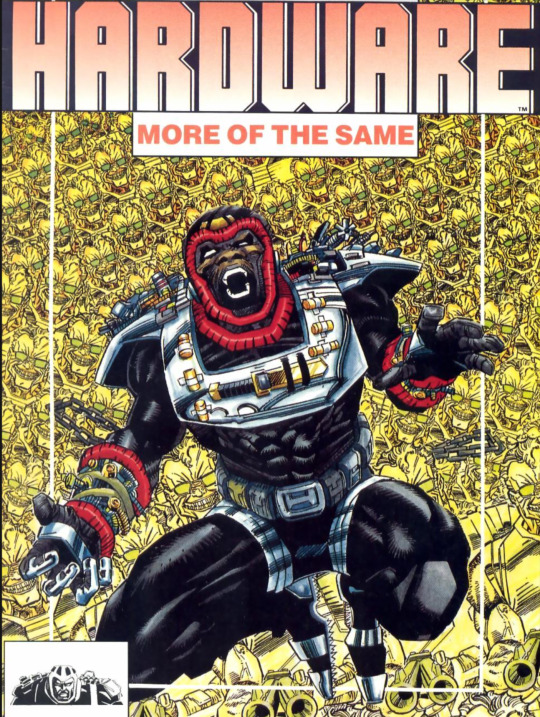
[ID: Hardware 1993 #2 "Reprisal" comics cover, with Curt Metcalf in his Hardware suit in the center, and hundreds of replicas of assassin Reprise in the background. The inscription above reads: "More of the same". End of ID]
#Curt Metcalf#hardware#hardware 1993#although honestly this comics is sooooooooo good#like#for real#y'all either sleeping on it or secretly reading and never told me#at least from what i've read so far it really seems like people who were writing this love the story love the character#they give a shit#you will too since page 1 with the bird and glass ceiling metaphor#i have zero brains to do analysis or good post describing everything#but look. this dude is supersmart#and when he found out his benefactor - a guy who was like a better father than his father in his own words#not only exploits him but also basically the center of a corruption network and nobody either gives a shit or can do anything about it#and Curt was like - i am going to set up base in Alva's basement and destroy everything he tries to do#and he was so right for it!
0 notes
Text


Well at least they’re honest about it
0 notes
Text







Hardware #1 & 2 (1993) by Milestone / DC Comics
Written by Dwayne mcDuffie, drawn by Denys Cowan and Jimmy Palmiotti.
#Hardware#DC Comics#Milestone#Milestone Comics#1993#Denys Cowan#Dwayne McDuffie#Etsy#Vintage Comics#Comic Books#Comics#Jimmy Palmiotti#Curtis Metcalf#Reprise#Edwin Alva#Joe James
1 note
·
View note
Text
Tonight I got to show my boyfriend Big Eden (2000). I love that movie so much. It's sappy and cheesy but no one had EVER made a gay romcom like like that. No queer movie had existed with that softness and living acceptance. It's 5 years older than the homophobic misery porn of Brokeback Mountain being held up as representation we should be grateful for. Big Eden broke as many barriers as Philadelphia (1993) or The Boys in the Band (1970).
Queer romcoms are only now becoming common 20 years later. Bros (2022) would have no queer Hallheart movies to simultaneously mock and long for without Big Eden. No The Way He Looks (2014), no Cloudburst (2011), no Fire Island (2022), no Spoiler Alert (2022), no Booksmart (2019), and no countless other films.
They exist because Thomas Bezucha said we deserve these stories, too. We deserve gentleness and love and small town crushes held onto for decades and someone who pours all their feelings into cooking for you and pretends it's not him because he's too shy. He deserve a Greek Chorus of old men who do nothing all day getting roped into it and hardware store lesbians and an old busybody playing matchmaker that realizes her errors. We deserve silly love triangles with gentle endings for everyone. We deserve the fantasy of it all. We deserve no queer people dying or being pressured by their family or corrected by anyone. Just love. Sappy, soft, gentle, healing, protective love. We deserve our own take on old tropes. And that's still something special.
160 notes
·
View notes
Text
Early Texturing in Games
For the first arcade game with textures, Ridge Racer is one hell of a showing! Something like this running at 512x384 at 60FPS in '93 would only be matched when the Dreamcast released in 1998

The first game with hardware texturing was surprisingly in the home space: The aptly-named Crash 'n Burn for the 3DO, which came out with the system a few days before Ridge Racer that October. It would be the only 3DO game released in 1993. I don't know for sure, but I have a hunch that its extremely linear gameplay suggests it might be using a system where the vertices (polygon edge points) of the track/environment are pre-calculated and used for when the system actually draws the polygons at runtime, similar to Winter Gold ('96, SNES) or the intro of Silpheed ('86, NEC PC-8801mkIISR)
The first games to use texturing period were both software-rendered DOS games: Catacomb 3D and Ultima Underworld in '91 and '92 respectively.

Catacomb 3D is an Id Software game inspired by an early showing of Ultima Underworld at CES 1990, and it uses a software raycasting engine that would later be popularized by Wolfenstein 3D, Doom 1&2, and Duke Nukem 3D. Only the walls are textured, but hey, it was early days

Ultima Underworld uses a software polygon renderer and is fully textured. It ended up directly inspiring Tomb Raider, and it's not hard to see why. Aside from the tiny viewport, severe texture warping and 2D objects, it's pretty comparable to King's Field 1 from '94 on the PS1!
24 notes
·
View notes
Text
William Hootkins in the 1990s (2 of 3)
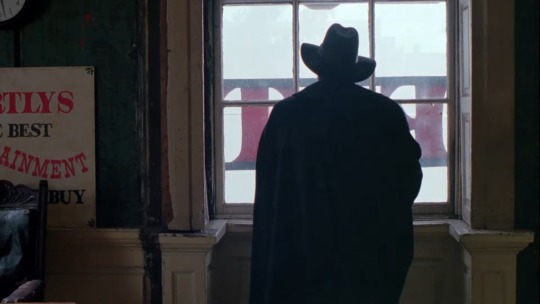




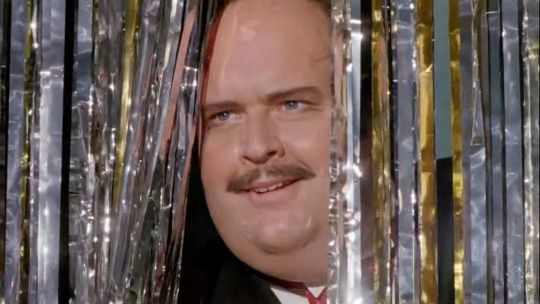






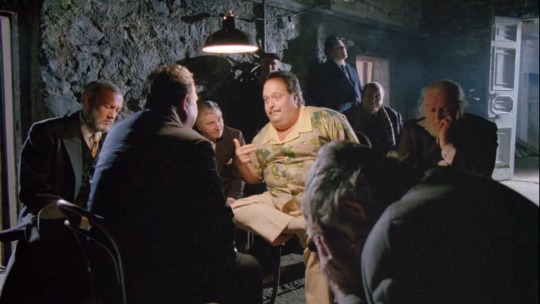


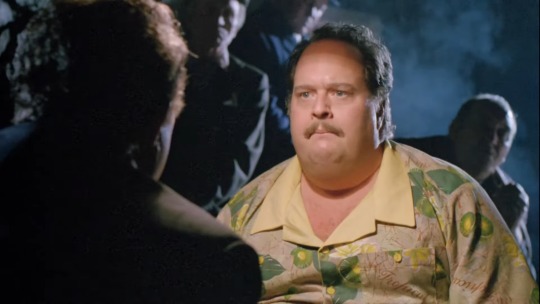

In late 1991, William Hootkins had a major role in Hear My Song by rookie co-writer/director Peter Chelsom. It is a fun film and Hootkins looks like he had a ball while doing it.


In 1992, Hootkins did another film with Hardware writer/director Richard Stanley, Dust Devil. I haven't seen this film either.


Also in 1992, William Hootkins appeared in major motion picture A River Runs Through It with Brad Pitt.



Hootkins also appeared in an episode of The Young Indiana Jones Chronicles.


In 1993 Hootkins appeared in UK TV movie Age of Treason.
#William Hootkins#sexy fat actor#1990s#actor born in us and living in uk#Dust Devil+#A River Runs Through It#Hear My Song#Age of Treason#The Young Indiana Jones Chronicles: Barcelona May 1917
26 notes
·
View notes
Text
Did you know?
In 1993, Italian game company MarcSoft released a cult classic game called "Inferno Summit" for the Nintendo Entertainment System.

The game is known for having a lofty development time of 6 years. As a result, the sprites have this extremely polished feel that other games on the system wouldn't be able to replicate due to strict hardware limitations.
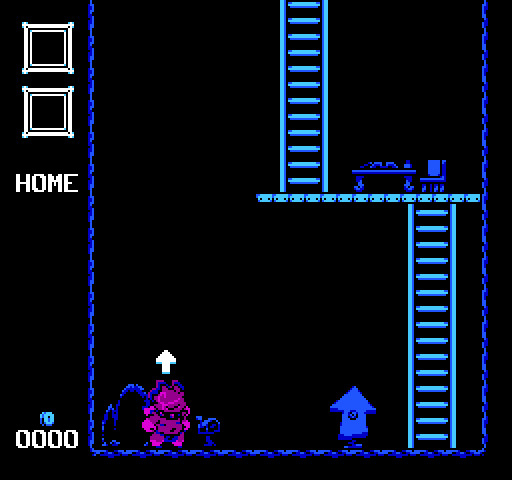


#art#furry art#furry#artists on tumblr#oc#demon#my oc#demon oc#sfw furry#pixel art#pixel#nes#nintendo#retro#retro gaming#fake game#fake games
79 notes
·
View notes
Text

get in losers. i am embarking on a journey to play and review every mainline* sonic game, in order*, on as much original hardware as i can. as of right now, the only games ive ever actually played are the original three on genesis, and mania - i have never actually played a 3d sonic game. i am so excited! i am also so incredibly bad at video games!! therefore im not holding myself to 100%ing them, or even getting all the emeralds unless its plot relevant. im just looking to complete the "canon" or best story and hopefully have a good time.
*completely arbitrary distinction based on what i actually want to play, list and current collection image under readmore

(im not including spinball or 3d blast in this project but i have them so in the collection image they go)
(1991) sonic the hedgehog - genesis
(1993) sonic the hedgehog cd - emulated 2012 version*
(1992) sonic the hedgehog 2 - genesis ($9.99 manual)
(1993) sonic chaos - game gear ($4.99)
(1994) sonic the hedgehog 3 - genesis
(1994) sonic & knuckles - genesis ($29.99 + $20 manual)
(1999) sonic adventure - dreamcast (~$50)**
(2001) sonic adventure 2 - dreamcast (~$75)**
(2001) sonic advance - gba ($20)
(2002) sonic advance 2 - gba ($15)
(2004) sonic heroes - gamecube ($20 + $18 manual)
(2004) sonic advance 3 - gba ($15)
(2005) shadow the hedgehog - gamecube ($64)
(2005) sonic rush
(2006) sonic the hedgehog
(2007) sonic and the secret rings
(2007) sonic rush adventure
(2008) sonic unleashed - wii ($19.99)
(2009) sonic and the black knight
(2010) sonic colors - wii
(2013) sonic lost world
(2014) sonic boom
(2017) sonic mania - switch ($34.99)
(2017) sonic forces
(2022) sonic frontiers
(2024) sonic x shadow generations
current price total: ~$371.95
(i am not including the prices of consoles in the total cost, but i have already purchased a dreamcast for this project and intend to get a game gear in the future. also if a game i have doesn't have a price it's because my brother gave it to me)
* out of chronological order due to continuity
**SA and SA2 were purchased bundled with a dreamcast console, two controllers, and mvc2 for $350 total so prices on the games alone are approximate.
if a game has a console listed then i have it. also for as much as id love to play sonic cd on original hardware, sega cds go for around $200 and thats awfully steep for a console i want exactly one game for :(
#swift meows#swift plays sth#ill just reblog this post whenever i finish one so mute it if you want#also theres no timeframe for this ill get to them when i get to them and also i dont have them all yet#i love you blue hedgehog :]
13 notes
·
View notes
Text
9 People you'd like to get to know better
thank you for tagging me @dangerousdan-dan!!
three non romantic duos: renee and vic (the questions!!!), cass and jpv (the 'i was raised to be a human weapon from birth but i've moved away from that and decided to do good' buddies!), and dick and donna (the wonder twins :D)
a ship that might surprise others: while i haven't sought this ship out that much, i think raven/tara is pretty interesting as a ship.
last song: eusexua by fka twigs
last film: maybe the madoka magica movie
currently reading: hardware (1993) and impulse (1995)
currently watching: revolutionary girl utena
currently consuming: hmm nothing at the moment
currently craving: i want to draw but i also want to read comics, so instead i'm on tumblr lol
tagging (no pressure!!): @franollie @vechter @aingeal98 @ghostmakerz @butch-chastity @crispy-crust
14 notes
·
View notes
Text
StEx Appreciation Month Day 19: Purse





Favourite Actor?
Cary Chennell, Robert Hardware, Gary Albers, Reginald Jennings, Anthony Starr.
Favourite Song/Scenes?
Pearl/Dinah you've been honoured and his interaction with Electra in AC/DC.
Favourite Costumes?
Uhhhh Bochum of course :)
Favourite Ships/Friendships?
Ships: Purse/Krupp and Electronents
Friendships: Components, Espresso, Dinah, Pearl
Headcanons?
He's a bit of a snob but you can't help but love him. He can also do big math equations without a calculator.
Unpopular Opinion?
None... I miss himmmm
Photo 1: Anthony Starr - Bochum 2017.
Photo 2: Todd Talbot - London 2001.
Photo 3: David Allwood - Bochum 2011.
Photo 4: Marvin Engran - Las Vegas 1993.
Photo 5: Robert Hardware - Bochum.
9 notes
·
View notes
Text
This is also Curtis' car

#i like it when they give us character car details#anyway hardwarer 16 is the issue with the details about all his new sui tech ain teh back#dc comics#milestone comics#hardware 1993#curtis metcalf
0 notes
Text
Hardware (1993)
Okay, so I finished the first 4 issues of Hardware. And it's amazing, groundbreaking, awe-inspiring. I read a review that was like "yeah it was good for its time" - excuse me? It's good, period. It's a comic book that doesn't treat neither the reader nor the character half-heartedly. It was as much a pleasure to read dialogue as follow the fighting sequence. The metaphors, which I raved about earlier, are very cleverly used. The story itself, in my opinion, has great weight and relevance.
Slightly spoilery description below.
You feel for Curt, a smart and talented black man, who, sure, gets some chances other peers wouldn't necessarily get (the school his benefactor puts him in, college fund). But when he graduates, and goes to work for Alva - the rich white dude in question - and makes him so much money with his inventions and innovative technology. Alva builds his company's profits and reputation on his back. It's only fair that Curt wants to have a part of this company, a share of the revenue created by him. He did that, he made all those millions possible. But he gets cold water thrown in his face. The man he thought was his friend, his equal, basically almost family - he never considered him any of those things. Just a tool.
Driven by this injustice and realizing that his benefactor isn't the benevolent man he thought he was, Curt starts to investigate him. If that's what he did to Curt, then what did he do at other times, when there's no such a link of debt between them? (and yes, at this point Curt returned more than enough to Alva to consider Alva being indebted to him)
Turns out, Alva also launders money, sells stolen weapons, and more. And Curt tries to do the right thing and sends the information to the police, to politicians, to the press. He doesn't hear back. The reason is simple as that: Alva is in the center of a web of corruption. Nobody has the desire or/and political will and power to take him down.
So, Curt builds himself a suit, using his workplace as a warehouse, a storage unit, and a temporary base. And he names his suit - his superhero name - Hardware.
Now that I know more about the reasoning behind the name, I appreciate this choice even more.

[ID: a comic panel from "Hardware" comics, #4. There is a bird perch. Curt Metcalf is hanging his helmet on it. He says: "Hey, you asked the question first: what do I want to accomplish? I don't know the answer yet... But I'm convinced that somehow, Hardware is the right tool for the job."
Next panel, he takes away his hand. A parakeet lands on the perch, on his helmet's strap."
End of ID]
The art (especially the suits) takes some to get used to, like any late eighties - nineties comics, but it is very worth it. Besides, other times it's outright pretty, as seen above.
10 notes
·
View notes
Photo



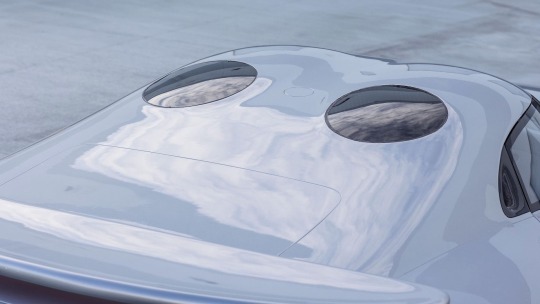



Dodge Viper-based Defender prop car from “Viper”
Set in the "near future" as envisioned in the early 1990s, "Viper" was about a federal task force based in fictional Metro City, California, that fought crime using an armored vehicle called the Defender that masqueraded as a Dodge Viper. The show first aired in early 1994 on NBC and continued in syndication between 1996 and 1999.
The Defender was designed by Chrysler, and built on a stretched 1993 Dodge Viper RT/10 chassis by Unique Movie Cars in Las Vegas. A 360-cubic-inch Chrysler V-8 replaced the Viper V-10, driving the rear wheels through a Chrysler 727 3-speed automatic transmission. The suspension, steering, and brakes are thought to be carryover Viper hardware, according to the auction listing.
The driver faces three round instruments, including a 180-mph speedometer, a 7,000-rpm tachometer, and a fake crosshair sight, with three simulated screens off to the side showing static images of fictional vehicle diagnostics. The two seats are upholstered in gray leather, but the car lacks seat belts and climate control. You can get fresh air by removing the windows, though, which are attached by Velcro.
Photo via Bring a Trailer
#art#design#sportcar#sportcars#luxurycars#luxurycar#dodge#dodge viper#defender#bringatrailer#tv show#1990s#metrocity#california#NBC#UNIQUEMOVIECARS#MOVIES#chrysler#V8#Sports
106 notes
·
View notes
Photo






Hardware #1 (April 1993) by Milestone / DC Comics
Written by Dwayne McDuffie, drawn by Denys Cowan and Jimmy Palmiotti;
#Hardware#Milestone#Milestone Comics#DC Comics#Denys Cowan#Jimmy Palmiotti#Angry Black Man#Dwayne McDuffie#Vintage Comics#Etsy#1993#Comic Books#Comics#Edwin Alva#Curtis Metcalf#Reprise
0 notes
Text
Guía sobre Debian: El Pilar de las Distribuciones Linux
1. Introducción
Presentación de Debian
Debian es una de las distribuciones Linux más antiguas y respetadas, conocida por su estabilidad, seguridad y adherencia a los principios del software libre. Fundada en 1993 por Ian Murdock, Debian ha servido como base para muchas otras distribuciones populares, incluyendo Ubuntu.
Importancia y legado de Debian en el ecosistema Linux
Como una de las "distribuciones madre", Debian ha jugado un papel crucial en el desarrollo y popularización de Linux. Su robustez y compromiso con el software libre lo han convertido en una elección preferida tanto para servidores como para entornos de escritorio.
2. Historia y Filosofía de Debian
Origen y evolución de Debian
Debian fue creado con la intención de ser una distribución gestionada de manera abierta y colaborativa. Desde su lanzamiento, ha tenido múltiples versiones, cada una con nombres basados en personajes de la película "Toy Story".
Filosofía y compromiso con el software libre
Debian sigue estrictamente las Directrices de Software Libre de Debian (DFSG), lo que significa que todo el software incluido en la distribución debe ser libre. Además, su contrato social garantiza la transparencia y la cooperación dentro de la comunidad.
3. Características Clave de Debian
Estabilidad y seguridad
Debian es conocido por su estabilidad, lo que lo convierte en una opción confiable para servidores y sistemas de producción. Las actualizaciones y nuevos paquetes se prueban rigurosamente antes de ser lanzados en la versión estable.
Gestor de paquetes
APT (Advanced Package Tool) es el gestor de paquetes principal de Debian. APT facilita la instalación, actualización y eliminación de software desde los repositorios de Debian.
Comandos básicos: sudo apt update, sudo apt install [paquete], sudo apt remove [paquete].
Formatos de paquetes soportados
Debian soporta varios tipos de archivos para la instalación de software:
.deb: El formato nativo de Debian para la instalación de paquetes.
.appimage: Formato portátil que puede ejecutarse directamente sin necesidad de instalación.
.snap: Aunque no es nativo de Debian, se puede habilitar soporte para instalar paquetes Snap.
.flatpak: Otro formato universal que puede ser instalado en Debian, aunque requiere la instalación previa de Flatpak.
Ramas de desarrollo
Stable (Estable): Ideal para entornos donde la estabilidad es crítica.
Testing (Pruebas): Contiene paquetes más recientes y es una buena opción para usuarios que desean un equilibrio entre estabilidad y novedades.
Unstable (Inestable/Sid): Donde se introduce el software más nuevo y experimental.
Amplia compatibilidad de hardware
Debian soporta una amplia gama de arquitecturas de hardware, desde las más comunes como x86 y ARM, hasta plataformas más especializadas.
4. Proceso de Instalación de Debian
Requisitos mínimos del sistema
Procesador: Pentium 4 o posterior.
Memoria RAM: 512 MB para un sistema básico, 1 GB o más recomendado para un entorno de escritorio completo.
Espacio en disco: 10 GB mínimo, 20 GB o más recomendados para una instalación con múltiples aplicaciones y entornos de escritorio.
Tarjeta gráfica: Compatible con X Window System.
Unidad de CD/DVD o puerto USB para la instalación.
Descarga y preparación del medio de instalación
El sitio web oficial de Debian ofrece imágenes ISO para descargar. Se puede preparar un USB booteable usando herramientas como Rufus o balenaEtcher.
Guía paso a paso para la instalación
Selección del entorno de instalación: Debian ofrece opciones de instalación tanto gráfica como en modo texto.
Configuración de particiones: Se puede optar por particionado automático o manual, dependiendo de las necesidades del usuario.
Configuración de la red y selección de paquetes: Durante la instalación, se configuran las opciones de red y se seleccionan los paquetes de software esenciales.
Primeros pasos post-instalación
Actualización del sistema: Es recomendable ejecutar sudo apt update && sudo apt upgrade para asegurarse de que el sistema esté completamente actualizado.
Instalación de controladores y software adicional: Dependiendo del hardware, puede ser necesario instalar controladores específicos. Además, se pueden instalar entornos de escritorio adicionales o programas específicos.
5. Entornos de Escritorio en Debian
Gnome (predeterminado)
Gnome es el entorno de escritorio predeterminado en Debian, conocido por su simplicidad y enfoque en la productividad.
KDE Plasma
Un entorno de escritorio altamente personalizable que ofrece una experiencia visualmente atractiva.
Xfce
Ligero y eficiente, ideal para sistemas con recursos limitados.
LXQt y otros
Alternativas para quienes buscan un entorno aún más ligero o con diferentes características.
6. Gestión de Paquetes en Debian
APT: El gestor de paquetes de Debian
Comandos básicos: apt-get, apt-cache, aptitude.
Instalación y eliminación de paquetes: sudo apt install [paquete], sudo apt remove [paquete].
Repositorios y backports
Debian ofrece diferentes repositorios: stable, testing, y unstable, así como backports que permiten instalar versiones más recientes de software en la rama estable.
Configuración de repositorios adicionales
Los usuarios pueden añadir repositorios adicionales en el archivo /etc/apt/sources.list para acceder a más software.
7. Debian en el Entorno Empresarial y Servidores
Uso de Debian en servidores
Debian es ampliamente utilizado en servidores debido a su estabilidad y seguridad. Es ideal para aplicaciones web, bases de datos, y como servidor de correo, entre otros.
Mantenimiento y soporte a largo plazo
Debian ofrece soporte a largo plazo (LTS) para sus versiones estables, garantizando actualizaciones de seguridad por al menos cinco años.
Herramientas de administración y automatización
Debian se integra bien con herramientas como Ansible, Puppet, y Docker, facilitando la gestión de infraestructuras complejas.
8. Comparativa de Debian con Otras Distribuciones
Debian vs. Ubuntu
Objetivo: Ubuntu se basa en Debian y se orienta más hacia el usuario final, con actualizaciones más frecuentes y un enfoque en la facilidad de uso.
Filosofía: Mientras que Debian sigue estrictamente los principios del software libre, Ubuntu incluye software propietario para mejorar la compatibilidad y experiencia del usuario.
Debian vs. CentOS
Objetivo: CentOS, basado en Red Hat, es otra opción popular para servidores, enfocada en la estabilidad y soporte a largo plazo en entornos empresariales.
Filosofía: CentOS es más conservador en cuanto a actualizaciones, mientras que Debian, aunque estable, ofrece más flexibilidad en la gestión de paquetes.
Debian vs. Arch Linux
Objetivo: Arch Linux es para usuarios avanzados que desean un sistema minimalista y personalizado, con un modelo de actualización continua (rolling release).
Filosofía: Debian prioriza la estabilidad, mientras que Arch sigue la filosofía KISS (Keep It Simple, Stupid) y proporciona control total al usuario.
9. Conclusión
Debian como una opción sólida y confiable
Debian sigue siendo una de las distribuciones más confiables y seguras disponibles. Su enfoque en la estabilidad y el software libre lo convierte en una elección excelente para usuarios, administradores de sistemas y desarrolladores.
Recomendaciones finales para quienes consideran usar Debian
Debian es ideal para aquellos que valoran la estabilidad sobre la última tecnología y están dispuestos a invertir tiempo en aprender sobre su gestión y mantenimiento.
10. Preguntas Frecuentes (FAQ)
¿Debian es adecuado para principiantes?
Aunque Debian es más técnico que distribuciones como Ubuntu, es accesible para principiantes con paciencia y disposición para aprender.
¿Cómo actualizo mi sistema Debian?
Ejecutando sudo apt update && sudo apt upgrade mantendrás tu sistema actualizado.
¿Es Debian una buena opción para servidores?
Sí, Debian es muy utilizado en servidores debido a su estabilidad, seguridad y soporte a largo plazo.
#Debian#distribución Linux#Linux#servidor Debian#instalación Debian#software libre#GNOME#KDE#APT#gestión de paquetes#Debian Stable#Debian Testing#Debian Sid#comunidad Debian#recursos Debian#seguridad en Debian#soporte a largo plazo#Debian vs Ubuntu#Debian vs CentOS#Debian vs Arch Linux#formatos de paquetes#.deb#.appimage#.snap#.flatpak
10 notes
·
View notes